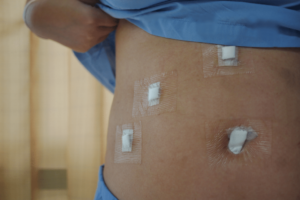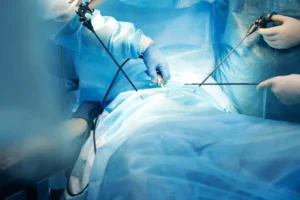What are the treatment options for gallstones?
Surgery is the standard in the treatment of gallstones. The gallbladder is removed in
an operation through keyhole surgery (laparoscopic cholecystectomy).
In laparoscopic cholecystectomy, small stab incisions are made in the belly under GA (general
anaesthesia) and through the use of special instruments under magnified vision with high definition telescopes, the gallbladder is carefully and meticulously dissected and removed from the liver bed. Laparoscopic cholecystectomy regularly involves an overnight stay in hospital, but in certain
cases, a same day discharge
might be possible.
In about 1 in 10 patients, keyhole surgery might not be possible for various reasons. This might be decided based on the clinical situation before the operation is done, or decided during an
attempted laparoscopic cholecystectomy when a proper visualisation of the gallbladder is not
possible. In these cases, an open operation (open cholecystectomy) might be proposed or undertaken. In an open cholecystectomy, a longer cut is made beneath the right margin of the
rib cage to access the gallbladder for its removal. A longer recovery is expected after the open
operation, and a stay of 2 to 5 days in hospital is normal.
What are the possible complications of cholecystectomy?
While there are risks associated with any kind of surgery, the vast majority of cholecystectomy
patients experience few or no complications. Complications, as infrequent as they come, include
bleeding, infection, pneumonia, blood clots or heart problems. Unintended injury to adjacent
structures such as the common bile duct (0.4%) or small bowel may occur and may require another
surgical procedure to
repair it.
What are the advantages of laparoscopic cholecystectomy?
Laparoscopic (key hole surgery) removal of the gallbladder employs the use of a special camera on a telescopic lens and long skinny instruments operating through small openings in the abdominal wall. Rather than a 10-15cm incision, the operation requires only 4 small openings in the abdomen, which in turn will decrease the amount of pain experienced post-operatively.
As a result, patients have a faster recovery than those with open operations, and are
able to go home within one day after surgery and return to normal activities quicker.
How about SILS?
SILS (single incision laparoscopic surgery) is a technique where surgery is performed through a
single incision in the belly button. SILS cholecystectomy allows the avoidance of the
additional 3 incisions that the standard laparoscopic cholecystectomy requires, for better cosmetic results. However, it has not been shown to confer recovery that is faster than what is
already expected for laparoscopic cholecystectomy, and may be associated with a higher risk of complications. Please check with your doctor if you are a suitable candidate.
Why do you need to remove the entire gallbladder for gallstones? Can’t you just remove the stones?
Gallstones are very unlike kidney stones, where stone removal is sufficient to ablate symptoms. In gallstone disease, the gallbladder is almost always inflammed and diseased as a result, such that even in the absence of stones, it will certainly contribute to symptoms and further stone formation
if left in-situ. It is therefore standard and sound medical treatment to remove the entire gallbladder for gallstone
disease.
There are no long-term nutritional or digestive consequences to the removal of the gallbladder.
How about alternative medicine for gallstones?
No alternative therapy has been proven to cure or dissolve gallstones.





















